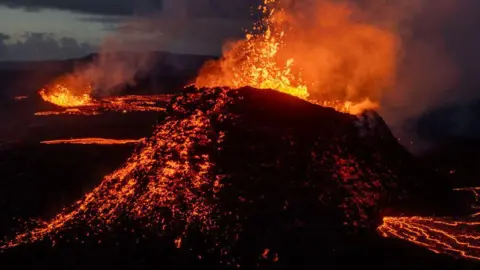 Getty Images
Getty ImagesI’m in one of the world’s volcanic hotspots, northeast Iceland, near the Krafla volcano.
A short distance away I can see the rim of the volcano’s crater lake, while to the south steam vents and mud pools bubble away.
Krafla has erupted around 30 times in the last 1,000 years, and most recently in the mid-1980s.
Bjorn Por Guðmundsson leads me to a grassy hillside. He is running a team of international scientists who plan to drill into Krafla’s magma.
“We’re standing on the spot where we are going to drill,” he says.
The Krafla Magma Testbed (KMT) intends to advance the understanding of how magma, or molten rock, behaves underground.
That knowledge could help scientists forecast the risk of eruptions and push geothermal energy to new frontiers, by tapping into an extremely hot and potentially limitless source of volcano power.
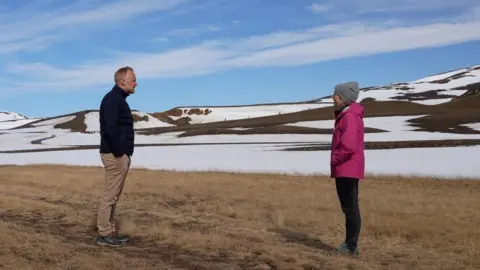
Starting in 2026 the KMT team will begin drilling the first of two boreholes to create a unique underground magma observatory, around 2.1km (1.3 miles) under the ground.
“It’s like our moonshot. It’s going to transform a lot of things,” says Yan Lavelle, a professor of vulcanology at the Ludvigs-Maximllian University in Munich, and who heads KMT’s science committee.
Volcanic activity is usually monitored by tools like seismometers. But unlike lava on the surface, we don’t know very much about the magma below ground, explains Prof Lavelle.
“We’d like to instrument the magma so we can really listen to the pulse of the earth,” he adds.
Pressure and temperature sensors will be placed into the molten rock. “These are the two key parameters we need to probe, to be able to tell ahead of time what’s happening to the magma,” he says.
Around the world an estimated 800 million people live within 100km of hazardous active volcanoes. The researchers hope their work can help save lives and money.
Iceland has 33 active volcano systems, and sits on the rift where the Eurasian and North American tectonic plates pull apart.
Most recently, a wave of eight eruptions in the Reykanes peninsula has damaged infrastructure and upended lives in the community of Grindavik.
Mr Guðmundsson also points to Eyjafjallajökull, which caused havoc in 2010 when an ash cloud caused over 100,000 flight cancellations, costing £3bn ($3.95bn).
“If we’d been better able to predict that eruption, it could have saved a lot of money,” he says.
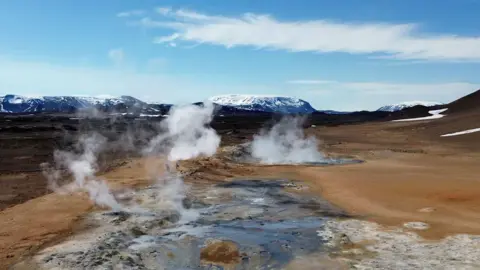
KMT’s second borehole will develop a test-bed for a new generation of geothermal power stations, which exploit magma’s extreme temperature.
“Magma are extremely energetic. They are the heat source that power the hydrothermal systems that leads to geothermal energy. Why not go to the source?” asks Prof Lavelle.
Some 65% of Iceland’s electricity and 85% of household heating, comes from geothermal, which taps hot fluids deep underground, as a source of heat to drive turbines and generate electricity.
In the valley below, the Krafla power plant supplies hot water and electricity to about 30,000 homes.
“The plan is to drill just short of the magma itself, possibly poke it a little bit,” says Bjarni Pálsson with a wry smile.
“The geothermal resource is located just above the magma body, and we believe that is around 500-600C,” says Mr Pálsson, the executive director of geothermal development at national power provider, Landsvirkjun.
Magma is very hard to locate underground, but in 2009 Icelandic engineers made a chance discovery.
They had planned to make a 4.5km deep borehole and extract extremely hot fluids, but the drill abruptly stopped as it intercepted surprisingly shallow magma.
“We were absolutely not expecting to hit magma at only 2.1km depth,” says Mr Pálsson.
Encountering magma is rare and has only happened here, Kenya and Hawaii.
Superheated steam measuring a recording-breaking 452°C shot up, while the chamber was an estimated 900°C.
Dramatic video shows billowing smoke and steam. Acute heat and corrosion eventually destroyed the well.
“This well produced about 10 times more [energy] than the average well in this location,” says Mr Pálsson.
Just two of these could supply the same energy as the power plant’s 22 wells, he notes. “There is an obvious game changer.”
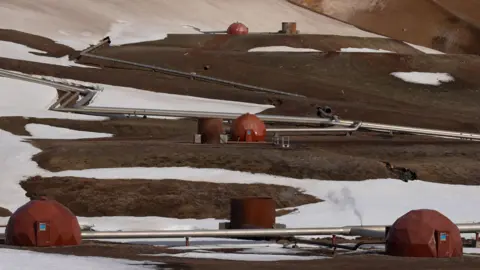
More than 600 geothermal power plants are found worldwide, and hundreds more are planned, amid growing demand for round-the-clock low carbon energy. These wells are typically around 2.5km deep, and handle temperatures below 350°C.
Private companies and research teams in several countries are also working towards more advanced and ultra-deep geothermal, called super-hot rock, where temperatures exceed 400°C at depths of 5 to 15km.
Reaching deeper and much hotter, heat reserves is the “Holy Grail”, says Rosalind Archer, the dean of Griffith University, and former director of the Geothermal Institute in New Zealand.
It’s the higher energy density that’s so promising, she explains, as each borehole can produce five to 10 times more power than standard geothermal wells.
“You’ve got New Zealand, Japan and Mexico all looking, but KMT is the closest one to getting drill bit in the ground,” she says. “It’s not easy and it’s not necessarily cheap to get started.”
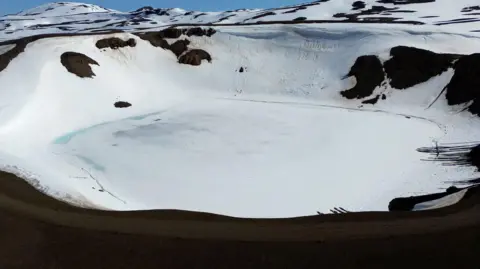
Drilling into this extreme environment will be technically challenging, and requires special materials.
Prof Lavelle is confident it’s possible. Extreme temperatures are also found in jet engines, metallurgy and the nuclear industry, he says.
“We have to explore new materials and more corrosion resistant alloys,” says Sigrun Nanna Karlsdottir, a professor of industrial and mechanical engineering at the University of Iceland.
Inside a lab, her team of researchers are testing materials to withstand extreme heat, pressure and corrosive gases. Geothermal wells are usually constructed with carbon steel, she explains, but that quickly loses strength when temperatures exceed 200°C.
“We’re focusing on high grade nickel alloys and also titanium alloys,” she says.
Drilling into volcanic magma sounds potentially risky, but Mr Guðmundsson thinks otherwise.
“We don’t believe that sticking a needle into a huge magma chamber is going to create an explosive effect,” he asserts.
“This happened in 2009, and they found out that they’d probably done this before without even knowing it. We believe it’s safe.”
Other risks also need to be considered when drilling into the earth like toxic gases and causing earthquakes, says Prof Archer. “But the geological environment in Iceland makes that very unlikely.”
The work will take years, but could bring advanced forecasting and supercharged volcano power.
“I think the whole geothermal world are watching the KMT project,” says Prof Archer. “It is potentially quite transformative.”
 topnaijanews Stay informed with the latest Nigerian news at your fingertips
topnaijanews Stay informed with the latest Nigerian news at your fingertips

